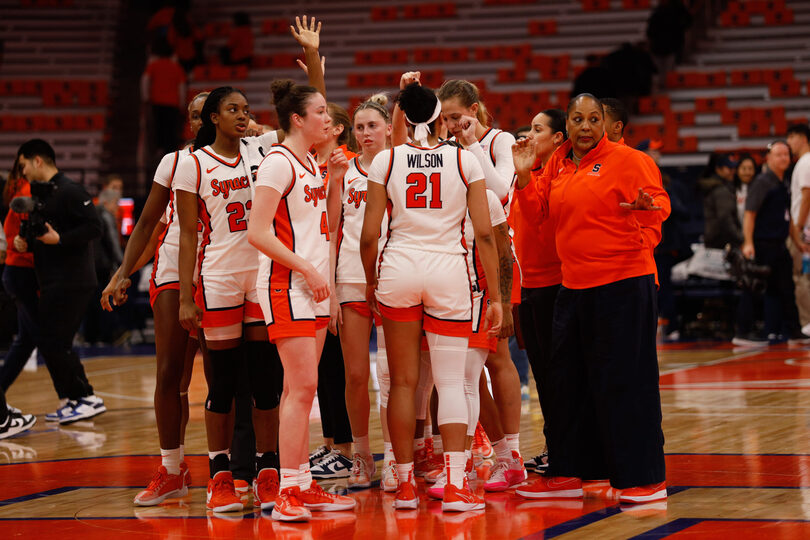Keys to success for No. 6 seed Syracuse in the 2024 NCAA Tournament

Syracuse is staring at a potential matchup against No. 3 seed UConn in the round of 32, if No. 6 seed SU can make it out of the first round. Nick Luttrell | Staff Photographer
Get the latest Syracuse news delivered right to your inbox. Subscribe to our sports newsletter here.
In any outcome to end the season, it remains clear that Felisha Legette-Jack has officially righted Syracuse’s ship away from turmoil. The second-year head coach helmed the Orange to their best regular season (23-6) since 2015-16 and their first NCAA Tournament appearance since 2021. For her grand effort, she was named the Atlantic Coast Conference Coach of the Year.
But that isn’t nearly enough for Legette-Jack. It’s only her second season, though she knows further postseason failure would be a missed opportunity. She’s built a team that has shown ability to beat top opponents — sweeping Notre Dame along with upsets over Louisville and Florida State. It’s her final chance to succeed in March alongside Dyaisha Fair, who has a professional career looming.
So, uncompetitive losses like the one SU suffered to FSU in the ACC quarterfinals are no longer tolerable. Legette-Jack doesn’t want her resurgent group to go to waste.
“We have a 23 (win) resume that says we are one of the 64 (NCAA Tournament) teams, and we’re going with our head up and we’re going with the gumption that we’re going out there to win six games,” Legette-Jack said on March 8.
Here are some keys to success for No. 6 seed Syracuse (23-7, 13-5 ACC) to make a deep run in the NCAA Tournament:
Feed Fair early and often
To take proper advantage of her final days in a Syracuse uniform, Legette-Jack’s squad must constantly put the ball in Fair’s hands. Yet, what’s been missing down the stretch for the Orange is providing Fair with vast room to work on the perimeter. They need to create space for Fair and let her rain from 3.
Essentially all of SU’s best victories have come from a dominant Fair performance. Her program-record nine 3s lifted them over Florida State in January, and she nailed four 3-pointers in both wins over Notre Dame.
Opponents have recognized the solution to thwarting Fair begins with applying intense on-ball pressure. Kara Lawson’s Duke implemented a full-court press on Feb. 22 which made Syracuse discombobulated in the half court, while also doubling Fair on the wings and trapping her on drives.

Dyaisha Fair racked up 105 3-pointers through Syracuse’s first 30 games in 2023-24, which was the second-most in the country. Arnav Pokhrel | Staff Photographer
Fair put up her worst shooting numbers of the season — 7-for-25 and 1-for-7 from 3 — in SU’s lowest team scoring output (45), falling by 13 to Duke. SU was out-rebounded by 27 and shot 25% as a team. These kinds of totals have shown more talented groups that focusing on Fair is the key to stopping Syracuse.
FSU head coach Brooke Wyckoff entered its ACC quarterfinals bout versus SU with a plan to force Fair inside, Wyckoff said postgame. And the plan worked. Fair was limited to a season-low five 3-point attempts in the 13-point defeat.
“The unfortunate part is that we let our opponent coaches believe that if you stop one of our players, then you stop Syracuse,” Legette-Jack said on March 8. “That’s what we’re going to go work on.”
To avoid offensive letdowns, the Orange need to rotate Fair off the ball and free her up with flare screens. Fair has a major weight to carry, and that will only be accomplished by receiving — and making — open 3-pointers.
Control the offensive glass
The Orange are one of the best offensive rebounding teams in the country, registering a 40.5% rate on the offensive glass and 16.3 boards per game — both rank No. 5 in Division I, per HerHoopStats.
It’s a beneficial quality to have when your go-to option is a volume 3-point shooter. Yet a lack of success with offensive rebounding has contributed to SU’s recent downfall.
In addition to the rebounding disaster against Duke, Syracuse allowed Florida State to garner 29 defensive rebounds to its 12 offensive rebounds while FSU’s Makayla Timpson grabbed 18 boards on her own. It led the Orange to generate just 10 second-chance points on a litany of short-lived possessions.
Some of the Orange’s struggles can be blamed on the absence of 6-foot-4 center Izabel Varejão, who was ruled out for the ACC Tournament due to an illness. Her status is unknown for the NCAA Tournament.
Either way, Kyra Wood, Alyssa Latham and Saniaa Wilson need to provide Syracuse with second-chance points. The three forwards aren’t imposing enough to center a game plan around feeding them in the post. With how reliant SU is in Fair taking 3s, it’ll need its frontcourt winning board battles for put-backs or to kick out to the perimeter.
Depth 3-point shooting
If it wins versus Auburn or Arizona in the first round, Syracuse will more than likely face No. 3 seed UConn in the round of 32 on March 25. The Orange have lost their last 19 matchups against the Huskies, a losing skid dating back to 1996. To come close to keeping pace with Geno Auriemma’s squad, SU needs efficient shooting from 3-point range.
The Huskies have five players who hold 33.3% clips or higher beyond the arc. Fair is the only one on Syracuse who matches that description. Even though Fair needs significant touches, secondary options like Georgia Woolley, Alaina Rice and Sophie Burrows will have to provide relief.
But that’s been hard to come by. Players other than Fair have only combined to make five or more 3s in just six of 30 contests. Woolley and Burrows have been inconsistent, currently possessing 3-point percentages of 28.2% and 23.6%, respectively. As a result, there’s more pressure on Fair to cancel out her teammates’ shortcomings.
UConn is the 25th-best 3-point shooting team in the nation, totaling a 35.8% clip so far this season. On paper, Syracuse looks like it’ll struggle to compete with a superior Huskies side. SU’s depth must fire on all cylinders from deep to have a shot at the Sweet 16.

Cole Ross | Digital Design Editor
Unlock Alaina Rice
It’s pretty simple. The time Syracuse was playing its best basketball coincided with a scorching run by Rice.
A 26-point outburst against Iowa State in November was the initial glimpse. She closed the year averaging a modest 10 points, 2.2 assists and 5.3 rebounds per game. But from Jan. 21 to Feb. 4, Rice went on the best stretch of her SU career. Across five games, Rice racked up 14 points and 2.4 steals a contest.
The peak was Rice’s performance during SU’s first-ever road win over Notre Dame on Jan. 26. She dropped 19 points on 7-for-12 shooting while being guarded by Hannah Hidalgo, the ACC Defensive Player of the Year. Hidalgo — who also leads the conference in scoring — got held to a middling 7-for-18 clip. Rice went toe-to-toe against one of the nation’s best and came out on top.
Rice hasn’t been the same since then. She finished in double-digit scoring just twice over her final eight appearances and shot 15-for-57 (26.3%) from the field. Her 1.4 steals per game during the final stretch was a steep drop-off, too.
Syracuse needs Rice to revert back to a steady No. 2 offensive option who’s also capable of shutting down star guards. Her offensive game works mostly inside, and if she gets back to penetrating the lane with physicality and finishing at the rim, she can develop a lethal combo with Fair.
Plus, Rice is SU’s best option at stopping UConn star Paige Bueckers. She will need to be held in check at least somewhat if the Orange were to even have a chance at a potential upset. But, Rice clamped Hidalgo. It’s not bullish to say she can lock down Bueckers.





